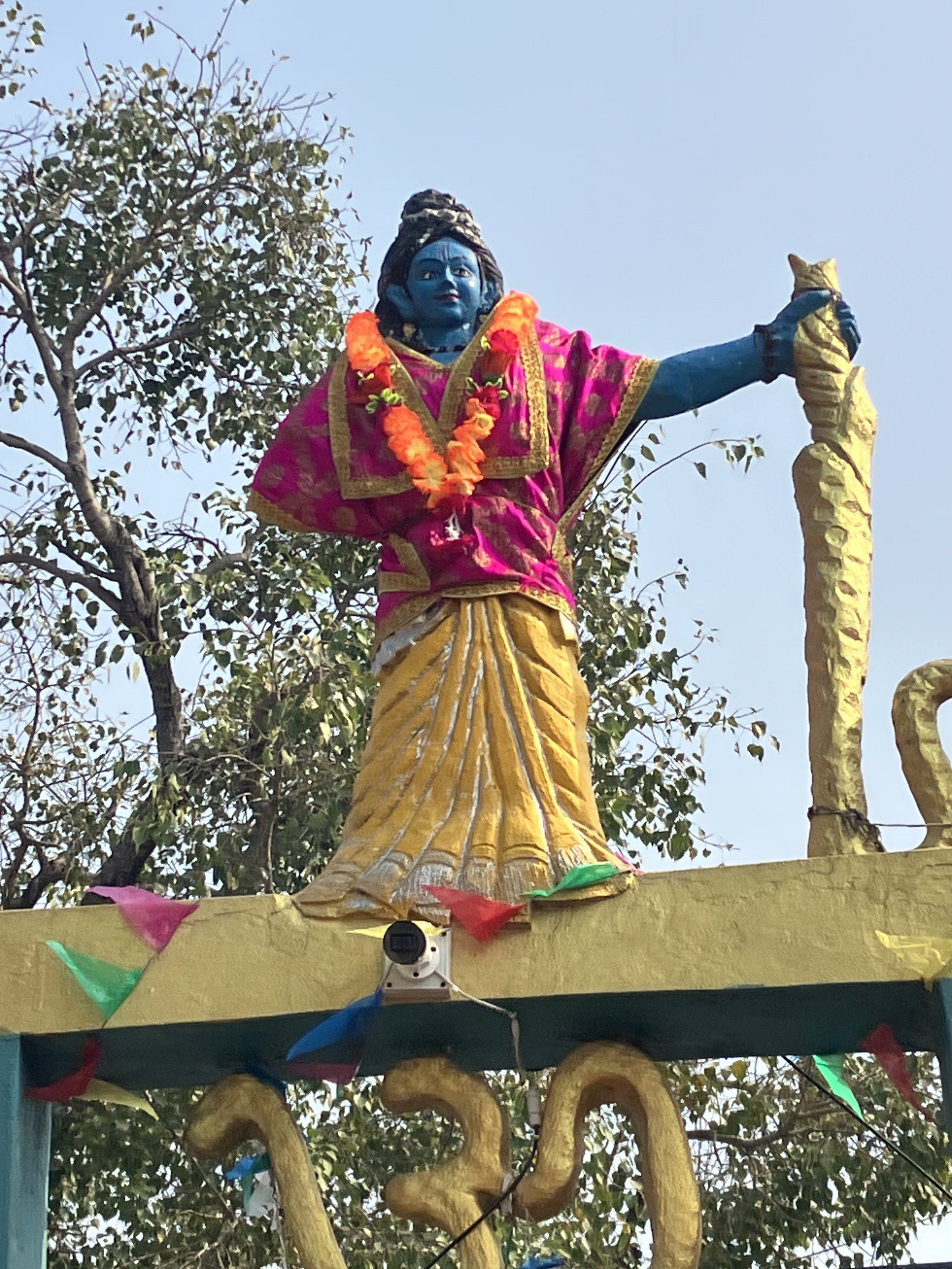Anuradha Kodagoda is a journalist and critic, and a film producer. With this blend of expertise and experience. She is the Deputy Features Editor in Sunday Observer, a flagship English newspaper in Sri Lanka. She is also a member of International Cinephile Society (ICS) and a regular contributor of ICS website and Celluloid Cinema magazine published by Dhaka International Film Festival.
Mithila Painting. Photo courtesy of the author.
Where the past dances with the present, the Cultural Village of Janakpur, Nepal, emerged as a living gallery hosting an inspiring workshop led by Sapana Sanjeevani, founding artist of Payal Sapana Paints, which illuminated the storied tradition of Mithila Art. I was swept away by this artistic tide and was fortunate to be part of the International Winter School 2024, titled ‘Pilgrimage as Placemaking in South Asia’. This immersive one week journey took place in the historic city of Janakpurdham, Nepal, a locale rich in stories and colour. Amidst many field visits, presentations and workshops, a workshop on Mithila Art collaborated by Payal Sapana Paints, a spirited collective of feminist Mithila artists and Incredible Mithila, a local organisation dedicated to preserving cultural and natural heritage stood out as a highlight.
Photo courtesy of the author.
In this unique workshop, several female artists participated alongside Sapana, including Rupa Devi from Madhubani, Bihar, India; Anjana Prajapati and Sushma Sah from Manjusa Art, Bhagalpur, Bihar; Hareram Yadav from Siraha, Nepal; Ritu Karn from Bara, Nepal; Sejal Karn from Parsa, Nepal; Dipa Karn from Dipa Art Gallery in Janakpur; Bina Kumari Karn from the Cultural Village Art Gallery; and Rubi Pathak from Mahottari, Nepal. Marking this unique collaboration, the group of Mithila artists created a beautiful mural near the railway station in Janakpur vividly showcasing their collective talent and vibrant cultural heritage.
History of Mithila Art
Mithila Art, also known as Madhubani painting, is a traditional art form that has flourished in the Mithila region of Nepal and parts of India, especially Bihar. This vibrant art is characterised by its knotty patterns, three primary colours and symbolic imagery, reflecting the cultural, social, and religious nuances of the communities it represents. At the workshop, Sapana, alongside other female artists, shared insights into this unique art form and its evolution.
The very first time one sees Mithila art, it evokes memories of the human anatomy drawings we created as children. According to historical accounts, Mithila Art originated in this region, where King Janak immortalised the legendary wedding of Rama and Sita through the brushstrokes of artists at that time, recreating the imagery for those who could not attend the wedding and setting the stage for generations of vibrant creativity.
“The origins of Mithila Art are steeped in history, with roots believed to extend back over 2,500 years. This art form was initially employed to depict significant cultural events, notably during the marriage of Lord Rama and Sita. Artisans were commissioned to paint walls with scenes from the majestic wedding ceremony to share the experience with those who could not attend” Sapana said.
Artistic characteristics
“Mithila Art is truly a treasure trove of creativity,” Sapana said. “It’s distinguished by two primary styles, Kachni which showcases intricate line work that twists and turns like knotted threads and Bharni which bursts forth with vibrant fills of colour.”
Traditionally, Mithila artists sourced pigments from nature, using extracts from flowers, herbs, and leaves. “This bond allows them to express their surroundings in a vibrant and organic way,” Sapana said. “Mithila art isn’t just pretty decorations; it’s a visual language that embodies a sense of place-making.” she further added.
Sapana explained how artists creatively utilised available spaces, whether on walls or mud surfaces, as their canvases to assert their identities and carve out their spaces in the world. “Imagine taking the very walls of your home and turning them into a canvas for your story. That’s what Mithila artists do,” she said.
Photo courtesy of the author.
The paintings themselves are a riot of colour, primarily featuring three striking hues: red, green, and yellow, all highlighted with bold black outlines. “These colours come from nature, connecting the art directly to the vibrant world we live in,” she said. Explaining the primitive nature one can witness in Mithila paintings compared with the realist painting tradition, Sapana said, “The figures in Mithila paintings often prioritise expression over anatomical accuracy; it’s all about conveying the essence of life rather than realism,” Sapana gestured towards a painting adorned with unique borders. “Look at those. The borders frame each piece, adding to their charm often filled with intricate patterns that draw the eye in. Every detail tells a story.”
Throughout history, Mithila Art has predominantly been practised by women in the community. The subjects are as diverse as the artists themselves, ranging from enchanting scenes of mythology and nature to poignant social commentary. “Mithila Art reflects what we see, experience and feel in our daily lives, it’s a living, breathing representation of community. It is a woman’s art, handed down through generations. Women express their lived experiences and stories through this art, creating a connection among themselves.” she added.
In Sapana’s words, Mithila art is not just an aesthetic endeavour, it’s a powerful vehicle for storytelling, social reflection and cultural identity, an endlessly vibrant gallery of human experience.
From tradition to livelihood
The commodification of Mithila Art has significantly shifted its role within the community, transforming the way artists engage with their craft. Traditionally viewed as a leisure activity for many women, creating art was a way to share stories, celebrate cultural rituals and beautify their homes. However, as the demand for Mithila artworks surged in local and international markets, this tradition evolved into a viable livelihood for numerous artists. The vibrant colours and intricate designs that once adorned the walls of homes are now sought after by collectors and enthusiasts worldwide, allowing artists to earn an income and gain recognition for their work.
Yet, with this commercialisation comes challenges that threaten the authenticity of the art form. As Mithila Art adapts to meet market demands, there is a growing concern about losing the cultural essence that is intrinsic to its identity. The process of commodification can sometimes overshadow the traditional practices and meanings that have been handed down through generations, leading artists to navigate a delicate balance between heritage and modernity.
In discussions around this evolving landscape, Anjana Prajapati and Sushma Sah from Manjusha Art said the critical importance of using the art form as a platform to address pressing social issues. “Through our paintings, we don’t just showcase beautiful art, we address topics like citizenship rights and social justice that deeply affect our community,” Anjana said. Anjana believes that art can serve as a medium for activism, shedding light on challenges faced by marginalised communities and igniting conversations that may otherwise go unheard.
The need for a distinct and resonant voice within the broader narratives of culture and identity is paramount for these artists. Sapana articulates this sentiment, advocating for the continuous evolution of Mithila art. “While we admire tradition, we also have to infuse contemporary issues that resonate with us today,” she said.
This evolution is not just about incorporating modern themes; it’s about ensuring that the art remains relevant to current generations while honoring its roots.
By intertwining traditional techniques with contemporary themes, Mithila artists are crafting a new narrative that reflect their lived experiences and responds to the realities of their communities. This approach allows them to reclaim their identities and assert their voices in a world that is constantly changing, while also fostering a sense of solidarity and empowerment among women in the community.
Challenging stereotypes and promoting change
One of the critical aspects of Mithila Art is its power to challenge stereotypes associated with women in the Madhesi community. Sapana articulates this sentiment, stating, “Mithila Art is not just about colours, rituals, or patterns; it’s a rich language of self-expression and empowerment for women.” The shared commitment among the artists to reclaim their narratives shapes how they approach their work.
The collective of female artists has been using their art to propel conversations around personal and social issues, often integrating themes of feminism and societal expectations. Ritu Karn from Bara adds, “As younger artists, we are tasked with upholding these traditions while also carving our paths and expressing modern narratives.”
The highlight is that Mithila art goes beyond aesthetic values. Rupa said, “This art form tells our stories. While we paint, we give voice to women’s issues, rights and cultural narratives that deserve to be heard.”
The future of Mithila Art
Photo courtesy of the author.
Looking ahead, the future of Mithila Art can be viewed as a blend of tradition and innovation. As younger generations engage with diverse mediums and techniques, they continue to redefine what Mithila art can represent. Their involvement is crucial to ensuring that the art form not only survives but thrives in a contemporary context.
“It is essential that we give agency to artists to decide how to express and reinterpret their stories. The art should reflect who we are today, not just what we were.” said Sapana. The support of local and State initiatives will be vital for the growth and recognition of Mithila Art as a significant cultural heritage that continues to evolve with its community.
In essence, Mithila Art stands as a powerful medium of expression for women, reflecting their identities, stories, and aspirations against the backdrop of cultural traditions that have persisted through generations. As artists such as Sapana Sanjeevani and her cohorts continue to innovate and inspire, this art form remains an essential space for dialogue, empowerment and resilience.












